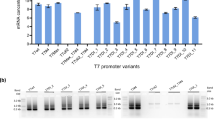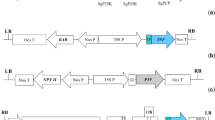Abstract
A reverse genetics system for thermostable Newcastle disease virus (NDV) is not currently available. In this study, we developed a reverse genetics system for the avirulent and thermostable NDV4-C strain. Successful recovery of NDV4-C was achieved by using either T7 RNA polymerase or cellular RNA polymerase II to drive transcription of the full-length virus antigenome from cloned cDNA. The recovered viruses rNDV4-C (T7) and rNDV4-C (CMV) showed similar growth properties, thermostability, and virulence as the parental strain NDV4-C. The potential of rNDV4-C (T7) to serve as a viral vector was assessed by generating a recombinant virus, rNDV4-eGFP, which expressed enhanced green fluorescent protein. The rNDV4-eGFP could stably carry and express eGFP for at least fifteen passages. The reverse genetics system for NDV4-C will make it possible to analyze the genetic elements that determine thermostability and the oncolytic properties of NDV.


Similar content being viewed by others
References
Alexander DJ (1989) Newcastle disease. In: Purchase HG, Arp LH, Domermuth CH, Perason JE (eds) A laboratory manual for the isolation and identification of avian pathogens, 3rd edn. American Association of Avian Pathologists, Kennett Square, PA, pp 114–120
Buchholz UJ, Finke S, Conzelmann KK (1999) Generation of bovine respiratory syncytial virus (BRSV) from cDNA: BRSV NS2 is not essential for virus replication in tissue culture, and the human RSV leader region acts as a functional BRSV genome promoter. J Virol 73:251–259
Czegledi A, Ujvari D, Somogyi E, Wehmann E, Werner O, Lomniczi B (2006) Third genome size category of avian paramyxovirus serotype 1 (Newcastle disease virus) and evolutionary implications. Virus Res 120:36–48
DiNapoli JM, Yang LJ, Samal SK, Murphy BR, Collins PL, Bukreyev A (2010) Respiratory tract immunization of non-human primates with a Newcastle disease virus-vectored vaccine candidate against Ebola virus elicits a neutralizing antibody response. Vaccine 29:17–25
Dortmans JC, Rottier PJ, Koch G, Peeters BP (2010) The viral replication complex is associated with the virulence of Newcastle disease virus. J Virol 84:10113–10120
Hu H, Roth JP, Estevez CN, Zsak L, Liu B, Yu Q (2011) Generation and evaluation of a recombinant Newcastle disease virus expressing the glycoprotein (G) of avian metapneumovirus subgroup C as a bivalent vaccine in turkeys. Vaccine 29:8624–8633
Hu S, Ma H, Wu Y, Liu W, Wang X, Liu Y, Liu X (2009) A vaccine candidate of attenuated genotype VII Newcastle disease virus generated by reverse genetics. Vaccine 27:904–910
Huang Y, Wan HQ, Liu HQ, Wu YT, Liu XF (2004) Genomic sequence of an isolate of Newcastle disease virus isolated from an outbreak in geese: a novel six nucleotide insertion in the non-coding region of the nucleoprotein gene. Brief report. Arch Virol 149:1445–1457
Huang Z, Krishnamurthy S, Panda A, Samal SK (2001) High-level expression of a foreign gene from the most 3′-proximal locus of a recombinant Newcastle disease virus. J Gen Virol 82:1729–1736
Huang Z, Panda A, Elankumaran S, Govindarajan D, Rockemann DD, Samal SK (2004) The hemagglutinin-neuraminidase protein of Newcastle disease virus determines tropism and virulence. J Virol 78:4176–4184
Ibrahim AL, Chulan U, Babjee AM (1981) An assessment of the Australian V4 strain of Newcastle disease virus as a vaccine by spray, aerosol and drinking water administration. Aust Vet J 57:277–280
Jiang Y, Liu H, Liu P, Kong X (2009) Plasmids driven minigenome rescue system for Newcastle disease virus V4 strain. Mol Biol Rep 36:1909–1914
Kattenbelt JA, Meers J, Gould AR (2006) Genome sequence of the thermostable Newcastle disease virus (strain I-2) reveals a possible phenotypic locus. Vet Microbiol 114:134–141
Kim SJ, Spradbrow PB (1978) Administration of a vaccine prepared from the Australian V4 strain of Newcastle disease virus by aerosol and drinking water. Aust Vet J 54:486–489
Lawson ND, Stillman EA, Whitt MA, Rose JK (1995) Recombinant vesicular stomatitis viruses from DNA. Proc Natl Acad Sci USA 92:4477–4481
Mayo MA (2002) Virus taxonomy—Houston 2002. Arch Virol 147:1071–1076
Mazija H, Cajavec S, Ergotic N, Ciglar-Grozdanic I, Gottstein Z, Ragland WL (2010) Immunogenicity and safety of Queensland V4 and Ulster 2C strains of Newcastle disease virus given to maternally immune, newly hatched chickens by nebulization. Avian Dis 54:99–103
Mebatsion T, Verstegen S, De Vaan LT, Romer-Oberdorfer A, Schrier CC (2001) A recombinant newcastle disease virus with low-level V protein expression is immunogenic and lacks pathogenicity for chicken embryos. J Virol 75:420–428
Olabode AO, Ndako JA, Echeonwu GO, Nwankiti OO, Chukwuedo AA (2010) Use of cracked maize as a carrier for NDV4 vaccine in experimental vaccination of chickens. Virol J 7:67
Panda A, Huang Z, Elankumaran S, Rockemann DD, Samal SK (2004) Role of fusion protein cleavage site in the virulence of Newcastle disease virus. Microb Pathog 36:1–10
Park MS, Steel J, Garcia-Sastre A, Swayne D, Palese P (2006) Engineered viral vaccine constructs with dual specificity: avian influenza and Newcastle disease. Proc Natl Acad Sci USA 103:8203–8208
Peeters BP, de Leeuw OS, Koch G, Gielkens AL (1999) Rescue of Newcastle disease virus from cloned cDNA: evidence that cleavability of the fusion protein is a major determinant for virulence. J Virol 73:5001–5009
Peeters BP, Gruijthuijsen YK, de Leeuw OS, Gielkens AL (2000) Genome replication of Newcastle disease virus: involvement of the rule-of-six. Arch Virol 145:1829–1845
Radecke F, Spielhofer P, Schneider H, Kaelin K, Huber M, Dotsch C, Christiansen G, Billeter MA (1995) Rescue of measles viruses from cloned DNA. EMBO J 14:5773–5784
Ramp K, Skiba M, Karger A, Mettenleiter TC, Romer-Oberdorfer A (2011) Influence of insertion site of the avian influenza virus haemagglutinin (HA) gene within the Newcastle disease virus genome on HA expression. J Gen Virol 92:355–360
Reed LJ, Muench H (1938) A simple method of estimating fifty per cent endpoints. Am J Epidemiol 27:493–497
Rout SN, Samal SK (2008) The large polymerase protein is associated with the virulence of Newcastle disease virus. J Virol 82:7828–7836
Schnell MJ, Mebatsion T, Conzelmann KK (1994) Infectious rabies viruses from cloned cDNA. EMBO J 13:4195–4203
Simmons GC (1967) The isolation of Newcastle disease virus in Queensland. Aust Vet J 43:29–30
Steward M, Vipond IB, Millar NS, Emmerson PT (1993) RNA editing in Newcastle disease virus. J Gen Virol 74(Pt 12):2539–2547
Tan WS, Lau CH, Ng BK, Ibrahim AL, Yusoff K (1995) Nucleotide sequence of the haemagglutinin-neuraminidase (HN) gene of a Malaysian heat resistant viscerotropic-velogenic Newcastle disease virus (NDV) strain AF2240. DNA Seq 6:47–50
Volchkov VE, Volchkova VA, Muhlberger E, Kolesnikova LV, Weik M, Dolnik O, Klenk HD (2001) Recovery of infectious Ebola virus from complementary DNA: RNA editing of the GP gene and viral cytotoxicity. Science 291:1965–1969
Xu Z, Sun L, Zhou J (1996) Breeding of variants Newcastle disease virus V4. Chin J Prev Veterinary Med 6:20–23
Yusoff K, Tan WS, Lau CH, Ng BK, Ibrahim AL (1996) Sequence of the haemagglutinin-neuraminidase gene of the Newcastle disease virus oral vaccine strain V4(UPM). Avian Pathol 25:837–844
Zhao H, Peeters BP (2003) Recombinant Newcastle disease virus as a viral vector: effect of genomic location of foreign gene on gene expression and virus replication. J Gen Virol 84:781–788
Zulkifli MM, Ibrahim R, Ali AM, Aini I, Jaafar H, Hilda SS, Alitheen NB, Abdullah JM (2009) Newcastle diseases virus strain V4UPM displayed oncolytic ability against experimental human malignant glioma. Neurol Res 31:3–10
Acknowledgments
We would like to thank Dr. Ming Liu and Dr. Henggui Liu for their providing many constructive suggestions. We further thank Dr. Kawaoka for providing plasmid pCAGGS-T7.
Author information
Authors and Affiliations
Corresponding author
Electronic supplementary material
Below is the link to the electronic supplementary material.
705_2013_1723_MOESM2_ESM.ppt
Supplementary material 2 Fig. S1 Construction, rescue, and confirmation of the stability of rNDV4-eGFP. A. Construction of infectious clone pV3-eGFP: The FseI restriction enzyme site was introduced into the region between the M and F genes of the pV3-V4 infectious clone by site-directed mutagenesis. The eGFP reporter gene was inserted into the FseI site with the NDV gene start and gene end sequences ahead of the start codon of eGFP. The Kozak sequence is marked in italics. (pro, promoter; ter, terminator; Le, leader; Tr, trailer). B. The rNDV4-eGFP virus was recovered from pV3-eGFP and used to infect BSR T7/5 cells (a). To verify the stability of eGFP in the genome of the rNDV4-eGFP virus, this virus was passaged through 9-day-old embryonated SPF eggs 15 times. The 1st, 5th, 10th, and 15th passages of rNDV4-eGFP-infected BSR T7/5 cells (b, c, d, and e, respectively) are shown. Uninfected cells served as the control (f). The arrows indicate autofluorescence. C. Confirmation of the eGFP gene in the genome of rNDV4-eGFP virus using RT-PCR. M, DL15000 DNA ladder marker; lanes 1 and 3, reactions without RT; lane 2, PCR products from the parental virus NDV4-C, with band size 2967 bp; lanes 4–7, PCR products from the 1st, 5th, 10th, and 15th passages of rNDV4-eGFP viruses, with a band size of 3723 bp; lane 8, PCR products from the plasmid pV3-eGFP, with a band size of 3723 bp. (PPT 245 kb)
Rights and permissions
About this article
Cite this article
Zhang, X., Liu, H., Liu, P. et al. Recovery of avirulent, thermostable Newcastle disease virus strain NDV4-C from cloned cDNA and stable expression of an inserted foreign gene. Arch Virol 158, 2115–2120 (2013). https://doi.org/10.1007/s00705-013-1723-6
Received:
Accepted:
Published:
Issue Date:
DOI: https://doi.org/10.1007/s00705-013-1723-6




